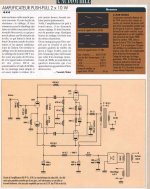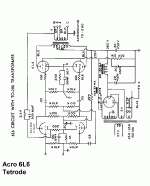I think most people abandoned zener ref voltage sinks in the cathode circuit. Although there were several threads that kind of petered out without any real conclusion.
My worst attempt with a zener was an 82V zener in the screen supply of a 6J9P. best described as godawful hiss. Even with film bypass caps.
I may have to go back and look at the frequency distribution of the noise.
I've also started experimenting with SuperCaps.
1F at 5V, I think that is about what it would take in parallel with the LEDs.
My worst attempt with a zener was an 82V zener in the screen supply of a 6J9P. best described as godawful hiss. Even with film bypass caps.
I may have to go back and look at the frequency distribution of the noise.
I've also started experimenting with SuperCaps.
1F at 5V, I think that is about what it would take in parallel with the LEDs.
I have mozener running in the OTL with high current mosfets..
Sounds like it could be interesting.. 🙂
IRF710 +zener couple of resistors. So is it fair to say that its just a case of measuring the voltage across a cathode load and match the LED Fwd volt drop
(taking into account current ie parallel LED's?) to try the LED bias..🙂 Perhaps adjust bias to ensure LED current is not exceeded.
Only on a low current circuit like the EL84. LOL
Regards
M. Gregg
Sounds like it could be interesting.. 🙂
IRF710 +zener couple of resistors. So is it fair to say that its just a case of measuring the voltage across a cathode load and match the LED Fwd volt drop
(taking into account current ie parallel LED's?) to try the LED bias..🙂 Perhaps adjust bias to ensure LED current is not exceeded.
Only on a low current circuit like the EL84. LOL
Regards
M. Gregg
Last edited:
This thread was like Shawshank Redemption. Started out slow, got ugly in the middle, towards the end Andy crawls out of a sewer and starts again clean. Wow.
Does any one have a link to,
Manley labs stingray circuit/ schematic?
What kind of PI does it use?
Picture link:
http://www.6moons.com/audioreviews/manley2/stingray.html
Edit a better link..
Regards
M. Gregg
Manley labs stingray circuit/ schematic?
What kind of PI does it use?
Picture link:
http://www.6moons.com/audioreviews/manley2/stingray.html
Edit a better link..
Regards
M. Gregg
Last edited:
It's got a balance pot near the PI tube:
6moons audio reviews: Manley Labs Stingray
Can't tell much else from the PC board picture. Could try counting caps maybe.
6moons audio reviews: Manley Labs Stingray
Can't tell much else from the PC board picture. Could try counting caps maybe.
If we look at the concertina and the floating paraphase they will have a quite similar harmonic pattern. Wrt to the LTP they will not have the even overtone cancellation. If we only check uneven harmonics they will probably all three be on par.
But we can make the floating paraphase cancel the even harmonics if we unbalance it, but I still prefer the balanced(ie. equal outputs from the driver triodes and higher even H).
In my world the concertina and paraphase win hands down with their +6dB gain wrt LTP.
Paraphase is best if my ears have to judge though.
But we can make the floating paraphase cancel the even harmonics if we unbalance it, but I still prefer the balanced(ie. equal outputs from the driver triodes and higher even H).
In my world the concertina and paraphase win hands down with their +6dB gain wrt LTP.
Paraphase is best if my ears have to judge though.
Any opinions on using some CCS/gyrators (high quality ones) in the plate loads for the paraphase? I would think that would lower the distortion further. (both even and odd harmonic)
Last edited:
I would think that would lower the distortion further. (both even and odd harmonic)
It will surely do.
Of course, but the effect is much less than in an amplifying stage. Nearly everything will benefit from a CCS - Just have a look at the solid state circuits. In a multi stage tube amp, there are many better things to improve than bringing the 2nd harmonic of a CF down from -40db to -50db. Just my 2 cents ;-)
I didn't follow the thread lately, but I spotted something about cathode decoupling. It doesn't have to be modern LED's. You can of course use tubes. For example the mostly useless (well, not for RF interested people like me - one word: Ratio-detector) EAA91/6AL5.
Here used as a cathode resistor for a 6N1P: 6AS7 Single Ended Amp mit Vorstufe
Look at the bottom of the page.
Yeah - its dynamic resistance isn't as low as LED, but 300Ohms is nice and a little current feedback is alos nice.
I didn't follow the thread lately, but I spotted something about cathode decoupling. It doesn't have to be modern LED's. You can of course use tubes. For example the mostly useless (well, not for RF interested people like me - one word: Ratio-detector) EAA91/6AL5.
Here used as a cathode resistor for a 6N1P: 6AS7 Single Ended Amp mit Vorstufe
Look at the bottom of the page.
Yeah - its dynamic resistance isn't as low as LED, but 300Ohms is nice and a little current feedback is alos nice.
Last edited:
I took a picture of the new paraphase amp I'm developing -this time a pentode amp with global feedback- but, alas, when I was going to show it to others I realized that the 'chassis' has some, pretty easy to spot, safety issues. Probably best to keep it out of public view. I'm heavily influenced on Steve's work these days, even my wiring which normally resembles subway networks has....... you gotta see my wiring on this one.
A 100k balance/unbalancer pot doesn't work as I had imagined. Global feedback makes things much more difficult. I'm listening to changes in the circuit using three sets of completely different speakers. Progress is slow.
Apart from not saying much of importance I'm posting a paraphase circuit found in an audiophile mag. This one comes with some numbers.
A 100k balance/unbalancer pot doesn't work as I had imagined. Global feedback makes things much more difficult. I'm listening to changes in the circuit using three sets of completely different speakers. Progress is slow.
Apart from not saying much of importance I'm posting a paraphase circuit found in an audiophile mag. This one comes with some numbers.
Attachments
I've seen damper tubes used before for biasing, 6AL5 could work for low mA.
What would interest me would be to try a thermionic diode for the tail of a differential stage. If its characteristic curvature could be tailored to fit correctly, the odd harmonic dist. of the differential should be nullable.
The paraphase Cassiel posted is surprising with the 470K Schade feebacks going back to the para triode plates. Rather low impedance loading on those triodes, but maybe a good way to get 2nd harmonic out of the PI if that's the goal.
What would interest me would be to try a thermionic diode for the tail of a differential stage. If its characteristic curvature could be tailored to fit correctly, the odd harmonic dist. of the differential should be nullable.
The paraphase Cassiel posted is surprising with the 470K Schade feebacks going back to the para triode plates. Rather low impedance loading on those triodes, but maybe a good way to get 2nd harmonic out of the PI if that's the goal.
Would someone,
Translate the caption at the bottom of Cassiel's drawing? Thank's 🙂
Regards
M. Gregg
Translate the caption at the bottom of Cassiel's drawing? Thank's 🙂
Regards
M. Gregg
Manually typing it into google translator, which you could have done.Would someone,
Translate the caption at the bottom of Cassiel's drawing? Thank's 🙂
"Amplifier circuit 2 x 10w pp. 6v6. The characteristics of 6v6 tubes, references
more popular than our outrefois Joure, are interesting because these tubes
easily found, at prices more competitive than those of EL34, KT66 or 6L6"
edit: "outrefois" may really be autrefois which is "once Joure" (French is not my language)
Last edited:
autrefois means "in former times"/"in the past"
The text simply says that 6V6 tubes are more easily to find and much cheaper than EL34,KT66 or 6L6 because they were very popular in the old days.
Today this of course doesn't make sense ! This article is from a former french magazine. A long time ago. There weren't any new production tubes on the market so everybody had to use NOS stock.
The text simply says that 6V6 tubes are more easily to find and much cheaper than EL34,KT66 or 6L6 because they were very popular in the old days.
Today this of course doesn't make sense ! This article is from a former french magazine. A long time ago. There weren't any new production tubes on the market so everybody had to use NOS stock.
Thanks for the clarification. Translating programs can only do so much.autrefois means "in former times"/"in the past"
I took a picture of the new paraphase amp I'm developing -this time a pentode amp with global feedback- but, alas, when I was going to show it to others I realized that the 'chassis' has some, pretty easy to spot, safety issues. Probably best to keep it out of public view. I'm heavily influenced on Steve's work these days, even my wiring which normally resembles subway networks has....... you gotta see my wiring on this one.
A 100k balance/unbalancer pot doesn't work as I had imagined. Global feedback makes things much more difficult. I'm listening to changes in the circuit using three sets of completely different speakers. Progress is slow.
Apart from not saying much of importance I'm posting a paraphase circuit found in an audiophile mag. This one comes with some numbers.
nice mean green audio machine.
a 100k pot is bad audio alchemy. Let me put it this way, its dumb to attenuate the amp that is what the preamp is for.
And I don't know why 100k seems to be the first choice for diyers there only 4 instances where 100k really works like it should. this isnt one of them.
remove 100k pot, install 500K pot and a/b removing the 470K resistor in the input grid circuit.
But there is nothing new as always:
Attachments
Last edited:
- Status
- Not open for further replies.
- Home
- Amplifiers
- Tubes / Valves
- Unusual amps..

